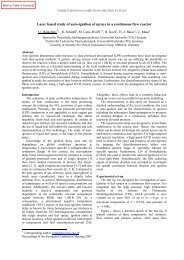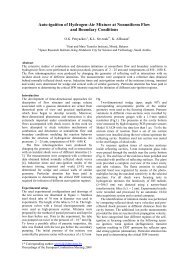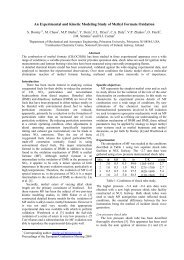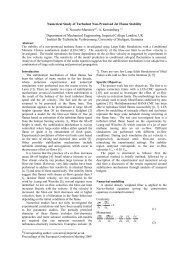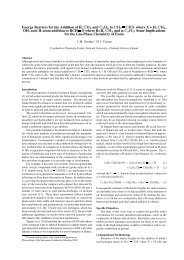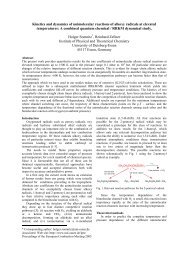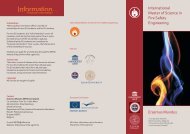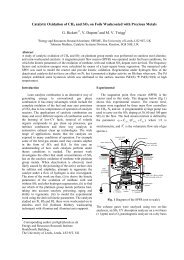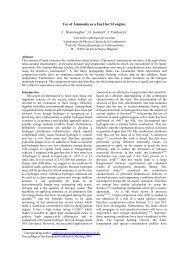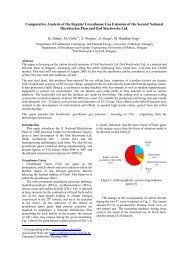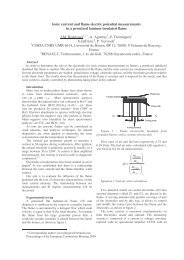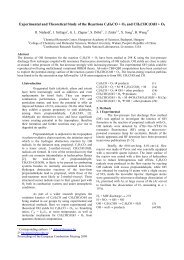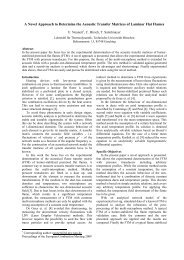Experiments and Large Eddy Simulation of Underventilated Pool Fires
Experiments and Large Eddy Simulation of Underventilated Pool Fires
Experiments and Large Eddy Simulation of Underventilated Pool Fires
Create successful ePaper yourself
Turn your PDF publications into a flip-book with our unique Google optimized e-Paper software.
<strong>Large</strong> <strong>Eddy</strong> <strong>Simulation</strong>s<br />
Numerical modeling <strong>of</strong> underventilated pool fires<br />
was performed using Fire Dynamics Simulator (FDS),<br />
Version 5, developed at NIST, with the accompanying<br />
Smokeview viewer for visualization <strong>of</strong> results [7-9].<br />
Earlier, FDS was successfully applied to modelling <strong>of</strong><br />
underventilated burner fires [6]. In this work, the fire<br />
source was provided by evaporating liquid fuel, <strong>and</strong> the<br />
fuel supply rate is determined by the heat flux on the<br />
pool surface due to conduction <strong>and</strong> radiation. Thus, the<br />
evaporation rate cannot be set ad hoc, rather, it is determined<br />
in the course <strong>of</strong> the solution.<br />
The combustion model used in all LES simulations<br />
is that available in FDS by default <strong>and</strong> based on the<br />
mixture fraction approach in which a transport equation<br />
for the mixture fraction (defined to be 1 in the fuel <strong>and</strong> 0<br />
in the oxidizer) is solved [7, 8]. The state relations for<br />
the fuel (heptane was used to simulate the petroleum<br />
ether which is a mixture <strong>of</strong> several hydrocarbons) are<br />
applied to restore the species concentrations <strong>and</strong> assess<br />
the volumetric heat release rate. The reaction is assumed<br />
to proceed at an infinite rate, so that the fuel <strong>and</strong> oxidized<br />
cannot co-exist on both side <strong>of</strong> the surface where<br />
the mixture fraction corresponds to the stoichiometric<br />
conditions. It should be noted that, according to this<br />
model, the fuel ignites immediately upon entering the<br />
atmosphere, rather that after reaching the ignition<br />
source.<br />
The calculations have shown that simulations by<br />
FDS give adequate qualitative picture <strong>of</strong> the process, as<br />
was the case when burner fires were modeled previously<br />
[6]. However, quantitative characteristics <strong>of</strong> the process,<br />
most importantly, time to flame exhaust, are very sensitive<br />
to such parameters as absorption coefficient <strong>and</strong><br />
thermal properties <strong>of</strong> pool liquid, which are somewhat<br />
uncertain because petroleum ether is a mixture <strong>of</strong> several<br />
hydrocarbons. Also, convection in the burning pool is<br />
known to affect the burning rate, but is not taken into<br />
account in the FDS model. More detailed studies are<br />
required to assess the sensitivity <strong>of</strong> flame exhaust time<br />
to each parameter. In this paper, we present the results<br />
<strong>of</strong> preliminary calculations which demonstrate the predictive<br />
capabilities <strong>of</strong> LES model.<br />
In Figs. 11 <strong>and</strong> 12, the results obtained for the geometry<br />
<strong>of</strong> fire box used in the experiments described in<br />
the previous sections are presented. The opening was<br />
chosen to be 0.18 m high <strong>and</strong> 0.1 m wide, the fuel<br />
source was a square pan with the side <strong>of</strong> 150 mm.<br />
In Fig. 11, the distributions <strong>of</strong> volumetric heat release<br />
rate are presented (visualized by Smokeview<br />
viewer [9]) at four time instants, representing the main<br />
stages <strong>of</strong> the process: initial fuel-controlled combustion<br />
at t = 7 s, oxygen starvation <strong>and</strong> slumping <strong>of</strong> flame to<br />
the floor where oxygen is still available at t = 70 s,<br />
flame propagation towards the ventilation opening <strong>and</strong><br />
its emergence outside the fire box at t = 150 s, <strong>and</strong>,<br />
finally, developed external flaming at t = 240 s. The<br />
temperature fields in the plane <strong>of</strong> symmetry are shown<br />
at the same instants in Fig. 12. The time to flame exhaust<br />
obtained in the calculations (about 140 s) is <strong>of</strong> the<br />
same order as observed experimentally with the same<br />
pool size for openings 2 <strong>and</strong> 3, but more detailed comparison<br />
<strong>and</strong> analysis have yet to be done.<br />
Conclusions<br />
<strong>Experiments</strong> with underventilated pool fires have<br />
shown that the time to flame exhaust strongly depends<br />
on the size <strong>of</strong> the fuel source, compartment geometry<br />
<strong>and</strong> ventilation factor. The temperatures measured inside<br />
the box during the experiments were relatively low<br />
(in the range <strong>of</strong> 220÷310°C). The height <strong>of</strong> the fuel pan<br />
walls also affects the time to flame exhaust.<br />
In the pool fire experiments it was found that flame<br />
exhaust process is much more repeatable than in the<br />
burner fire experiments. It seems that pool fires are<br />
“self-organizing”: the fuel supply rate is controlled by<br />
the radiative feed from the flame. For the same fire box<br />
configuration, it results in more stable <strong>and</strong> repeatable<br />
flame development, at least in terms <strong>of</strong> flame exhaust.<br />
CFD modeling is capable <strong>of</strong> capturing the main features<br />
<strong>of</strong> underventilated pool fires, although detailed<br />
parametric study <strong>of</strong> coupled physical phenomena has<br />
yet to be done.<br />
Acknowledgments<br />
The research was supported by EPSRG (Grant No.<br />
GR/S69122/01) <strong>and</strong> Russian Science Support Foundation.<br />
References<br />
1. Bullen, M. L., <strong>and</strong> Thomas, P. H., Proc. Comb.<br />
Inst., 17: 1139-1148 (1978).<br />
2. Drysdale, D., An Introduction to Fire Dynamics<br />
(2 nd edition). Wiley, Chichester, UK, 1999.<br />
3. Chamberlain, G. A., Trans. IchemE, B, 72(B2):211-<br />
219 (1994).<br />
4. Sniegirev, A. Yu., Makhviladze, G. M., Talalov,<br />
V. A., <strong>and</strong> Chamchine, A. V., Combustion, Explosion<br />
<strong>and</strong> Shock Waves, 3(1):1-10 (2003).<br />
5. Sniegirev, A. Yu., Makhviladze, G. M., Talalov,<br />
V. A., Isaev, S. A., <strong>and</strong> Chamchine, A. V., Proc. 3 rd<br />
Conf. On Heat Transfer RNKT-3, Moscow, Russia,<br />
3: 227-230 (2002).<br />
6. Makhviladze, G. M., Shamshin, A. V., Yakush,<br />
S. E., <strong>and</strong> Zykov, A. P., Combustion, Explosion,<br />
<strong>and</strong> Shock Waves, 42(6):723-730 (2006).<br />
7. McGrattan, K., Hostikka, S., Floyd, J., Baum, H.,<br />
Rehm, R., Mell, W., McDermott, R., Fire Dynamics<br />
Simulator (Version 5): Technical Reference<br />
Guide. NIST Special Publication 1018-5 (2008 Edition);<br />
92 p. July 2008.<br />
8. McGrattan, K., Klein, B., Hostikka, S., <strong>and</strong><br />
Floyd, J., Fire Dynamics Simulator (Version 5):<br />
Users Guide. NIST Special Publication 1019-5<br />
(2008 Edition); 188 p. July 2008.<br />
9. Forney, G., User's Guide for Smokeview Version 5:<br />
A Tool for Visualizing Fire Dynamics <strong>Simulation</strong><br />
Data. NIST Special Publication 1017-5 (2008 Edition),<br />
142 p. July 2008.<br />
5



